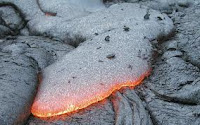Definition of Rocks :-
A rock may be difined as an aggregate of minerals of different kinds in varying proporation, occurring in natural condition. All meterials that make the earth's crust are called rocks. They may be soft like clay or hard like granite . clay , sand , slate and basalt are all rocks in the widest term of the world.
Classification of rocks :-
Rocks can be classified into three main types according to their mode of origin : (1) Igneous rocks , (2) Sedimentary rocks, (3) Metamorphic rocks.IGNEOUS ROCK :-
The igneous rocks are formed by cooling and solidification of hot molten lava and magma poured out on the earth's surface or poured in below the solid rock of the earth's crust by volcanic activity at the beginning when the earth born ,it was just a glowing ball of gas. Gradually, it cooled down and its molten volatile surface solidified. In this way the igneous rock formed at first on the earth's crust . Hence it is called primary rock. It has no layer and that is why it is called unstratified rock .
Classification of igneous rock according to its mode of formation :
The igneous rock originates from the hot molten lava and magma under various circumstance. According to the mode of formation , it can be classified into the following types : (1) Extrusive rock and (2) Intrusive rock.
Extrusive rocks :-
Extrusive rock is formed , when hot moltem lava pours out on the earth's surface and cools there. As its cools very rapidly , its forms very fine crystal. Thus extrusive rock is a fine-grained rock.
Basalt contains extremely fine crystal . Basalt is a very common rock in Chotanagpur plateau. It is also found in some parts of the lava plateau of Maharastra.
Example :-
Basalt contains extremely fine crystal . Basalt is a very common rock in Chotanagpur plateau. It is also found in some parts of the lava plateau of Maharastra.
Intrusive rocks :-
Intrusive rock is formed when magma intrudes into the earth's crust. As it cools there slowly,it forms large crystal. Thus intrusive rock is a coarse - grained rock.
Granite, Gabbro, Dolerite are example of intrusive rock may be further into two more types are (1) Plutonic rock and (2) Hypabyssal Rock
Example :-
Granite, Gabbro, Dolerite are example of intrusive rock may be further into two more types are (1) Plutonic rock and (2) Hypabyssal Rock
 |
| Fig :- Gabbro |
 |
| Fig :- Dolerite |
Plutonic rock :-
The magma which cools down very slowly in the deep underground of the earth's crust is called plutonic rock after pluto, the god of the under grounded. As it cools down very slowly , large crystals are formed in it . Thus plutonic rock is characterized by large crysalled, compactness and coarse texture.
Granite and Gabbro are plutonic rocks. these rocks are found in the Deccan plateau of India .
Example :-
Granite and Gabbro are plutonic rocks. these rocks are found in the Deccan plateau of India .
 |
| Fig :- Granite and Gabbro |
Hypabyssal rock :-
It is formed when intrusion of magma occurs in the cracks or along the lines of weakness in the earth's crust. As it cools down more rapidly than the plutonic rock but slower than the extrusive rock, smaller crystals than the plutonic rock , but larger than the extrusive rock , are formed.
Dolerite and Prophyrie are typical examples of hypabyssal rock. Dolerite and prophyrie are typical examples of Hypabyssal rock. Dolerite is commonly found in Jharia and Raniganj coalfields.
Examples :-
Dolerite and Prophyrie are typical examples of hypabyssal rock. Dolerite and prophyrie are typical examples of Hypabyssal rock. Dolerite is commonly found in Jharia and Raniganj coalfields.
Characteristics and uses of igneous rocks :-
(1) Igneous rocks are formed by cooling and solidification of hot molten lava and magma. (2) They are compact , massive and crystalline. (3) They contain several kinds of minerals ,though they are not rich in mineral resources. (4) They do not contain any fossil. (5) They are very usefull as building and road materials.






No comments:
Post a Comment